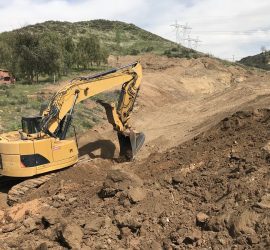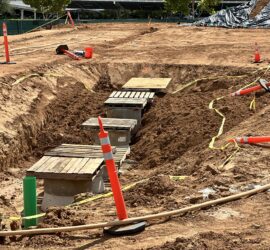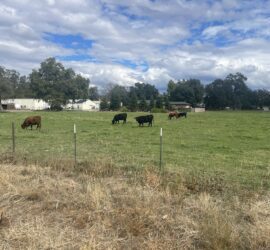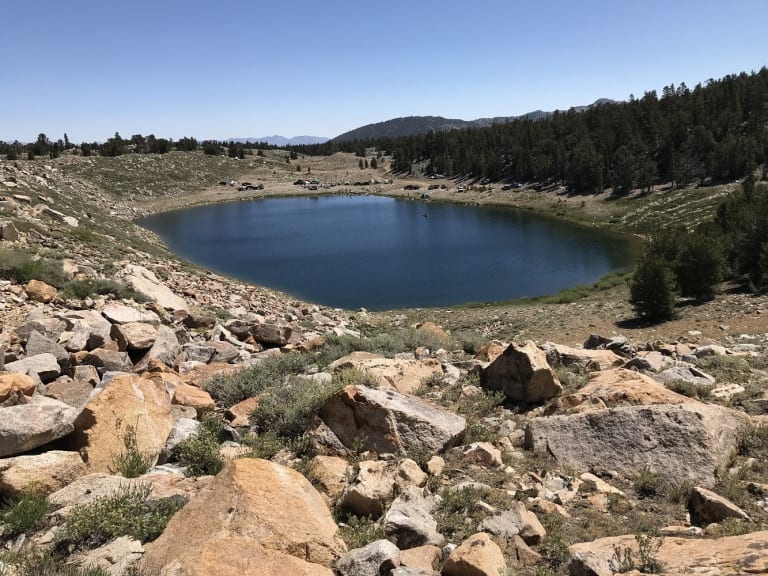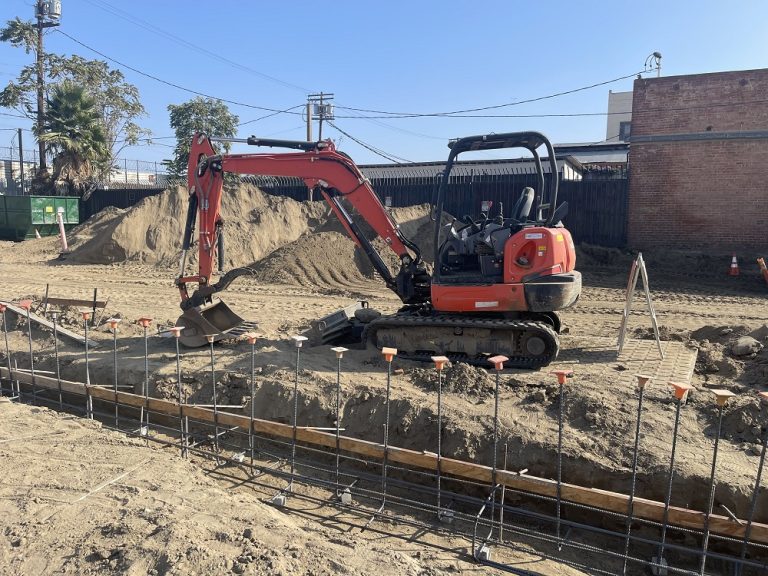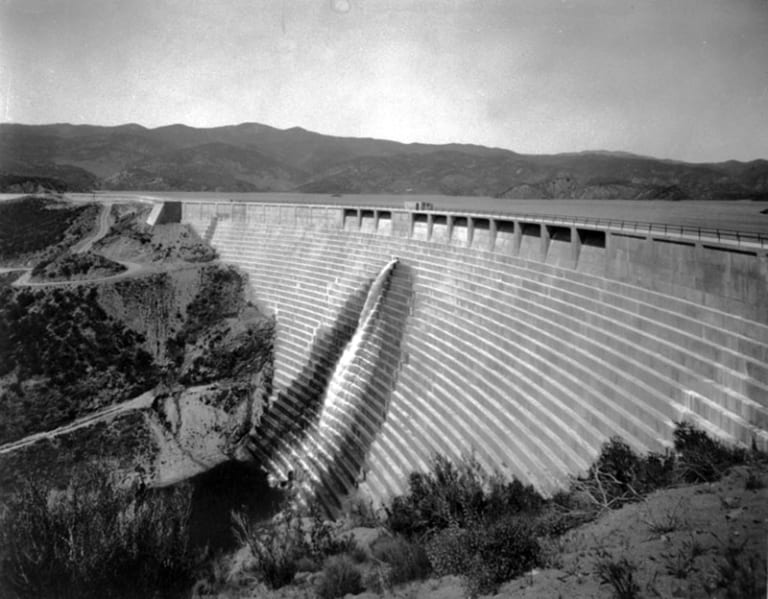Environmental Due Diligence at Laundromats & Dry Cleaners
Laundromat and dry cleaning services are very different operations but sometimes operate in the same facility. While laundromats generally do not present an inherent environmental risk, dry cleaners are some of the most common high-risk commercial land uses from an environmental standpoint. This is because the primary solvents that have historically been used for dry cleaning solutions are those containing volatile organic compounds (VOCs). For instance, tetrachloroethane (PCE) and trichloroethane (TCE). Updated April 10, 2024.
This Article is Not Legal Advice
This article serves to provide general information about the industry’s best practices, standards, and guidelines for conducting environmental due diligence on commercial real estate and businesses. Please note that the content of this memorandum is NOT legal advice. Geo Forward only guides on matters that relate to the environmental due diligence and engineering industries. For all legal inquiries, Geo Forward recommends consulting a licensed environmental attorney.
Subsurface Contamination
The primary chemical of concern associated with dry cleaning is PCE. Dry cleaning solvents such as PCE and TCE usually enter the subsurface through spills or improper disposal, but also through everyday use over extended periods, small leaks in equipment or sewer line piping can deposit the chemicals into the underlying subsurface. From there, the chemicals migrate downward in liquid form, and will then migrate back up vertically in the vapor phase.
Vapor Intrusion Concerns
The human health risk is primarily due to a possible vapor intrusion condition, where vapors re-enter the building through cracks in the slab, and/or migration through utility conduits, which would result in employees and patrons potentially being exposed to COCs through breathing the indoor air.
Standard Environmental Due Diligence
As a matter of standard practice, an ASTM Complaint Phase 1 Environmental Site Assessment (Phase 1 ESA) report is necessary for the due diligence of any commercial/industrial land acquisition. A complete Phase 1 ESA is generally required by lenders, government agencies, large financial and real estate institutions, and more because it aims to recognize any potential environmental risks (such as historical use of dry cleaner solvents). For instance, a Phase 1 ESA identifies “Recognized Environmental Conditions” through the reviews of historical regulatory agency databases, historical city directories, historical fire insurance maps, historical maps, publications and photographs, and/or interviews with on-site personnel.
If no obvious environmental risk is identified, the report would then recommend no additional studies. If there is a potential environmental risk associated with the site, the Phase 1 ESA report would then recommend a Phase 2 Environmental Site Assessment (Phase 2 ESA) for in situ contamination testing/verification.
Phase 1 ESA Limited-Alternative
An economical alternative to the Phase 1 ESA report is a limited environmental site assessment report, known as a “Desktop Environmental Review” (Desktop Report). Typically, a Phase 1 ESA is the standard procedure for any/all commercial/industrial properties. A Desktop Report may not meet the requirements of major banks, lenders, government agencies and financial institutions, but it may serve to keep potential property owners and purchasers informed of the environmental risk associated with a property, at a fraction of the cost of a Phase 1 ESA.
At a minimum, the environmental due diligence process for potential laundromat acquisitions should entail a Desktop Environmental Review, if not a complete Phase 1 ESA. If no obvious environmental risk is identified in the Desktop Report, the report would then recommend no additional studies. But, if there is a potential environmental risk, the Desktop Report would then recommend conversion to a complete ASTM-compliant Phase 1 ESA, and follow through with a Phase 2 ESA for in situ contamination testing verification.
Shallow Contamination Testing
As mentioned above, if no obvious environmental risk is identified in the Desktop Report and/or Phase 1 ESA, the report would then recommend no additional studies. But, if there is a potential environmental risk, a Phase 2 ESA for in situ contamination testing verification may be necessary. If the Phase 2 ESA shows chemical detections, or chemical detections below established environmental screening levels (which vary by state), then the report would recommend no further actions. If the Phase 2 ESA shows chemical detections above screening levels, additional investigation and/or remediation would be recommended.
Deep Contamination Testing
An additional investigation (Additional ESA) would consist of drilling deeper and more widespread samples to further delineate the lateral and vertical extent of contamination. Additionally, it is recommended to conduct Indoor Air Quality (IAQ) testing to provisionally screen for a potential vapor intrusion condition that could impact occupants.
If the Additional ESA shows no additional screening level exceedance, and IAQ is found to be acceptable, then no additional testing would be recommended. If the additional ESA shows deeper and/or greater contamination in the additional samples, and/or IAQ is found to be impacted by potential vapor intrusion, then mitigative or remedial actions are typically recommended at that point. There are several ways that each series of investigations could unfold, and it is important to remember that while this is a general template for environmental due diligence, each site must be individually considered on a case-by-case basis.
Contamination from Adjacent Sites
A Subject Property can be impacted by adjacent or nearby contaminated sites. The designation of responsibilities, duties, and clean-up/mitigation liability can vary on a case-by-case basis. Thus, for absolute legal liability concerns, Geo Forward would advise consulting a licensed attorney with the site-specific data and reports. However, the following are typical scenarios based on general observations and previous experiences:
- If there is an existing or historical dry cleaner on-site that is found to have contamination issues, the reasonable presumption (from a regulatory agency’s perspective) would likely be that the on-site dry cleaner caused the contamination. Thus, the owner of the Subject Property would likely be considered a “Responsible Party (RP)” in any regulated cleanup cases.
- However, if the Subject Property is affected by contamination from an adjacent/nearby site, the owner/occupant of the Subject Property may still have to take reasonable action to protect on-site building occupants, but also may not be considered the RP or causes of contamination. Ultimately, this determination is made by the Regulatory Oversight Agency with jurisdiction/authority.
Variables in Contamination Cases & Regulatory Oversight
Each case/site will be unique, with dynamics that will need to be individually addressed on a case-by-case basis. For all legal advice about liability and duties, a licensed attorney is advised for consultation. For all scientific purposes, such as data collection and interpretation, or even best practices for resting, clean-up, and closure, a consultation with a licensed professional geologist is advised.
Summary
To summarize, there is an inherent environmental risk associated with laundromats with a history of dry cleaner solvent use, as well as actual dry cleaners and/or properties within proximity to dry cleaners. Therefore, it is necessary to conduct the appropriate due diligence for such sites. For low-risk sites with no obligation to report to traditional lenders, banks, government agencies, or financial institutions, this process could start with a Desktop Environmental Review as the economical option. Otherwise, for higher-risk properties, or when there is a reporting obligation to third-party institutions, a comprehensive ASTM-compliant Phase 1 ESA is recommended to start.


